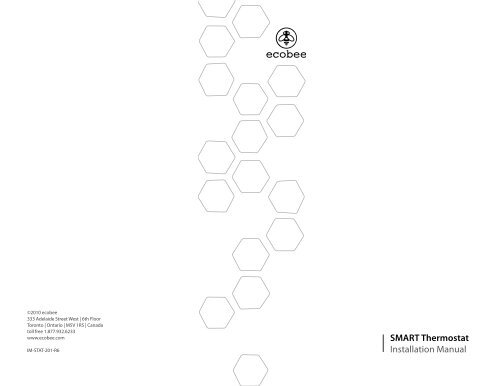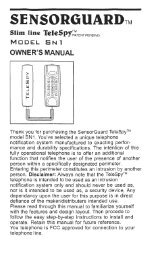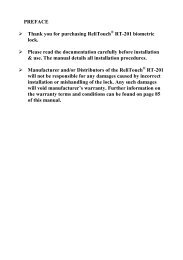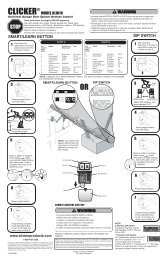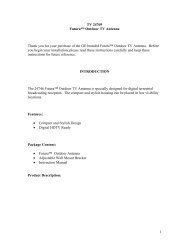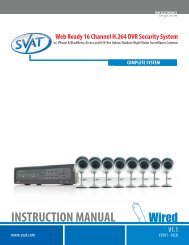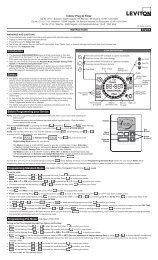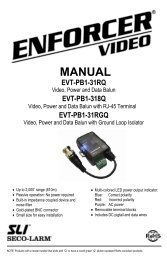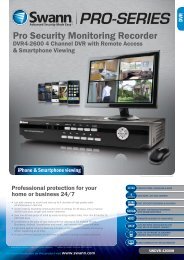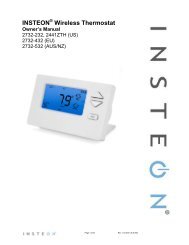SMART Thermostat Installation Manual - Smarthome
SMART Thermostat Installation Manual - Smarthome
SMART Thermostat Installation Manual - Smarthome
Create successful ePaper yourself
Turn your PDF publications into a flip-book with our unique Google optimized e-Paper software.
©2010 ecobee<br />
333 Adelaide Street West | 6th Floor<br />
Toronto | Ontario | M5V 1R5 | Canada<br />
toll free 1.877.932.6233<br />
www.ecobee.com<br />
IM-STAT-201-R6<br />
<strong>SMART</strong> <strong>Thermostat</strong><br />
<strong>Installation</strong> <strong>Manual</strong>
CONTENTS<br />
Getting Started 2<br />
Welcome 2<br />
HVAC System Compatibility Information 4<br />
Specifications 5<br />
Installing the ecobee Smart <strong>Thermostat</strong> 7<br />
Wiring Diagrams 9<br />
Equipment Interface Status LED 18<br />
Navigating the Smart <strong>Thermostat</strong> 19<br />
Configuring the Installer Settings 20<br />
Configuring the Reminder Alerts 27<br />
Performing a Hardware Reset 27<br />
Warranty 31
GETTING STARTED<br />
Welcome<br />
Thank you for supporting ecobee, the Smart <strong>Thermostat</strong><br />
that provides your customers with freedom and flexibility<br />
in managing their home environment.<br />
The ecobee Smart <strong>Thermostat</strong> has been designed<br />
in partnership with HVAC contractors to ensure the<br />
installation process is simple and efficient. This<br />
step-by-step <strong>Installation</strong> <strong>Manual</strong> will walk you through<br />
all aspects of the installation.<br />
To ensure an on-going service relationship with your<br />
customers, please register all of your ecobee Smart<br />
<strong>Thermostat</strong>s in your Contractor Portal.<br />
The ecobee Team<br />
Technical support<br />
Our technical support team is available to answer your<br />
questions at 1.877-9-ecobee (1.877.932.6233), or via<br />
email at support@ecobee.com.<br />
2
Before You Begin<br />
Equipment Description<br />
This product is intended to be installed by trained<br />
service professionals<br />
This manual explains the procedures for installing the<br />
ecobee Smart <strong>Thermostat</strong>. Please read it carefully before<br />
beginning the installation.<br />
For information on how to operate the ecobee Smart<br />
<strong>Thermostat</strong>, please see the ecobee User’s <strong>Manual</strong>.<br />
The ecobee Smart <strong>Thermostat</strong> consists of two parts<br />
(see images below):<br />
Gas/Oil/Electric heating (up to three stages)<br />
Heat pump with auxiliary heat (up to four stages)<br />
Geothermal Heat Pump<br />
Duel fuel systems<br />
Standard electric cooling (up to two stages)<br />
Boilers<br />
Yes<br />
Yes<br />
Yes<br />
Yes<br />
Yes<br />
Yes<br />
Central humidifier<br />
Central dehumidifier<br />
Yes<br />
Yes<br />
1.<br />
2.<br />
ecobee<br />
1. A Smart <strong>Thermostat</strong> to be mounted on the<br />
homeowner’s wall.<br />
2. An Equipment Interface Module This should be<br />
mounted in the homeowner’s utility room and<br />
connects to the heating, cooling and ventilation<br />
equipment.<br />
Caution: Disconnect electric power to the system before<br />
installing this product. Failure to do so could result in<br />
electric shock and/or equipment damage.<br />
All wiring must conform to your local electrical code.<br />
Mercury Notice: This product does not contain mercury.<br />
If you are replacing a product that does contain<br />
mercury please contact your local waste-management<br />
authority for disposal instructions. Do not discard the<br />
old product in the regular trash.<br />
HVAC System Compatibility information<br />
ecobee is designed to operate low-voltage heating and<br />
cooling systems. It is not designed for use with linevoltage<br />
or millivolt heating and cooling systems. ecobee<br />
supports control of up to four heating stages and two<br />
cooling stages. It also supports control of humidifiers,<br />
dehumidifiers, heat-recovery ventilators and<br />
energy-recovery ventilators.<br />
Heat Recovery Ventilator (HRV)<br />
Energy Recovery Ventilator (ERV)<br />
Sensors with dry contact outputs<br />
Approvals<br />
This product was designed and built in accordance to<br />
RoHS directive 2002/95/EC and contains no hazardous<br />
substances as defined by this directive.<br />
Optional Power supply meets EPA C.E.C Level IV and E.C<br />
CoC No Load power Consumption requirements. It is<br />
also safety approved to UL/cUL standards.<br />
FCC Compliance Statement<br />
Yes<br />
Yes<br />
Yes<br />
This equipment has been tested and found to comply<br />
with the limits for Class B digital devices, pursuant<br />
to Part 15 of the FCC Rules. These limits are designed<br />
to provide reasonable protection against harmful<br />
interference in a residential installation. This equipment<br />
generates uses and can radiate radio frequency energy<br />
and, if not installed and used in accordance with the<br />
instruction manual, may cause harmful interference to<br />
radio communications. However, there is no guarantee that<br />
interference will not occur in a particular installation.<br />
If this equipment does cause harmful interference to<br />
radio or television reception, which can be determined<br />
by turning the equipment off and on, the user is<br />
encouraged to try to correct the interference by one or<br />
more of the following measures:<br />
3 Getting Started<br />
Getting Started 4
Reorient or relocate the receiving antenna<br />
Increase the separation between the equipment<br />
and receiver<br />
Connect the equipment to an outlet on a different<br />
circuit from the receiver<br />
Consult the dealer or an experienced radio/TV<br />
contractor for help.<br />
Warning: Changes or modifications not expressly<br />
approved by ecobee Inc. could void the user’s<br />
authority to operate the equipment.<br />
To satisfy FCC/IC RF exposure safety requirements, a<br />
separation distance of 20 cm or more should be maintained<br />
between this device and persons. To ensure compliance,<br />
operation at closer than this distance is not allowed.<br />
FCC ID: WR9EBSTAT IC: 7981A-EBSTAT<br />
Specifications<br />
Temperature ranges<br />
Heat: 45 – 79°F (7 – 26°C)<br />
Cool: 58 – 92°F (14 – 33°C)<br />
Display: 40 – 100°F (5 – 37°C)<br />
Sensitivity: +/- 1°F (0.5°C)<br />
Equipment Interface Operating: -40o to 160oF (-40o to 70oC)<br />
<strong>Thermostat</strong> Operating: 32o to 130oF (0o to 55oC)<br />
Humidity Range<br />
Humidify: 20 to 50% R.H<br />
Dehumidify: 30 to 60% R.H<br />
Display: 0 - 90% R.H<br />
Sensitivity: +/- 2% R.H.<br />
Operating: 5 – 95% R.H non-condensing<br />
Dimensions<br />
<strong>Thermostat</strong>: 5.5”W x 3.25”H x 1”D (139.5mm H x 82.5mm<br />
W x 25mm D)<br />
Equipment Interface: 4.6”W x 10”H x 1.3”D (118mm W x<br />
254mm H x 32mm D)<br />
Power<br />
AC Transformer - 24 VAC - 3VA Minimum (not included)<br />
Battery – CR2032 – 3V lithium coin cell (included),<br />
Power Adaptor - #EB-PS-01 - 120V 50/60Hz to 12V DC 1A<br />
(not included)<br />
Wiring Specifications<br />
Refer to this table to determine maximum wire lengths allowed:<br />
Smart <strong>Thermostat</strong> to Equipment Interface<br />
18 AWG 20 AWG 22 AWG<br />
1250ft/380m 790ft/240m 500ft/150m<br />
Equipment Interface to heating/air equipment<br />
18 AWG 20 AWG 22 AWG<br />
128ft/39m 80ft/24m 50ft/15m<br />
Terminal Description and Electrical Ratings<br />
Terminal Description Voltage Current max<br />
Y 1st stage cooling 30V AC 3A<br />
W (O/B) 1st stage heating 30V AC 3A<br />
(or changeover)<br />
G Fan 30V AC 3A<br />
W2(AUX) 2nd stage heating 30V AC 3A<br />
(or 1st auxiliary heat)<br />
R/H Heat transformer return 30V AC 3A<br />
R/C Cool transformer return 30V AC 3A<br />
ACC1 1st accessory relay 30V AC 3A<br />
ACC1r 1st accessory relay return 30V AC 3A<br />
ACC2 2nd accessory relay 30V AC 3A<br />
ACC2r 2nd accessory relay return 30V AC 3A<br />
ACC3 3rd accessory relay 30V AC 3A<br />
ACC3r 3rd accessory relay return 30V AC 3A<br />
IN1 + Input 1 + Dry contact only Dry contact only<br />
IN1- Input 1 - Dry contact only Dry contact only<br />
IN2+ Input 2 + Dry contact only Dry contact only<br />
IN2- Input 2- Dry contact only Dry contact only<br />
+12v 12V DC power to <strong>Thermostat</strong> 8-14V DC 600mA<br />
GND GND to <strong>Thermostat</strong> - -<br />
D+ Data + communication line - -<br />
D- Data – communication line - -<br />
5 Getting Started<br />
Getting Started 6
Installing the<br />
Smart <strong>Thermostat</strong><br />
There are five steps to installing the ecobee Smart <strong>Thermostat</strong><br />
Step 1: Install the Equipment Interface.<br />
Step 2: Wire the Equipment Interface.<br />
Step 3: Install the Smart <strong>Thermostat</strong>.<br />
Step 4: Connect the Smart <strong>Thermostat</strong> to the<br />
Equipment Interface.<br />
Step 5: Power up both devices.<br />
Installing the Equipment Interface<br />
To install the Equipment Interface:<br />
1. In the homeowner’s utility room or basement, select<br />
a suitable location either on a wall or on the cold air<br />
return plenum. Make sure the surface is relatively flat<br />
and, if you are using a power adaptor, make sure there is<br />
an electrical outlet within five feet of where you plan to<br />
mount the device.<br />
2. Remove the front cover of the Equipment Interface. If<br />
necessary, Insert a flat-head screwdriver into one of the<br />
slots as shown below, and gently twist the screwdriver.<br />
Insert a screwdriver into one of the two slots and twist gently<br />
3. Place the back of the enclosure on the intended<br />
mounting surface and use it as a template to mark the<br />
location of the mounting holes, as shown below.<br />
Mounting holes indicated with solid color<br />
4. Move the back of the enclosure out of the way and<br />
make the holes where indicated in step 3. The mounting<br />
holes can accommodate a #6 pan-head screw.<br />
5. Use drywall plugs or other screw anchors (not<br />
included) to ensure the Equipment Interface can be<br />
mounted securely.<br />
6. Fasten the backplate to the wall using the appropriate<br />
screws (not included).<br />
Wiring the Equipment Interface<br />
To wire the Equipment Interface:<br />
1. Disconnect the power to the heating and air<br />
conditioning equipment.<br />
2. Disconnect the wires going to the existing <strong>Thermostat</strong>.<br />
3. Using the wiring diagrams on pages 9-14, connect<br />
the heating or air conditioning equipment to the<br />
Equipment Interface.<br />
4. Do not apply power until you have installed and<br />
connected the Smart <strong>Thermostat</strong>. (see instructions on<br />
page 15-18)<br />
5. Do not install the front cover on the Equipment<br />
Interface at this point.<br />
7 Installing The Smart <strong>Thermostat</strong><br />
Installing The Smart <strong>Thermostat</strong> 8
Wiring Diagrams<br />
Below are the Equipment Interface Terminal Labels<br />
Please take note that there is a factory installed jumper<br />
between R/H and R/C.<br />
Two Stage Heat/ Single Stage Cool With 3 Accessories<br />
24 Vac<br />
Power<br />
System<br />
Equipment Interface<br />
Furnace<br />
Air Conditioner<br />
IN2-<br />
IN2+<br />
IN1-<br />
IN1+<br />
D-<br />
D+<br />
GND<br />
+12V<br />
Line<br />
Communications<br />
Y<br />
W O/B<br />
G<br />
W2 AUX<br />
R/H<br />
R/C<br />
NC<br />
NC<br />
ACC1<br />
ACC1r<br />
ACC2<br />
ACC2r<br />
ACC3<br />
ACC3r<br />
Single Stage Heat/Cool With 3 Accessories<br />
HRV<br />
Dehumidifier<br />
Humidifier<br />
Y<br />
W O/B<br />
G<br />
W2 AUX<br />
R/H<br />
R/C<br />
ACC1<br />
ACC1r<br />
ACC2<br />
ACC2r<br />
ACC3<br />
ACC3r<br />
Y1<br />
W1<br />
G<br />
W2<br />
R<br />
Y2<br />
Hum<br />
C<br />
24V<br />
C<br />
24V<br />
C<br />
24V<br />
C<br />
24V<br />
C<br />
Humidifier<br />
Two Stage Heat/Cool With 2 Accessories<br />
Dual Stage Heat, Single Stage Cool with Three Accessories<br />
HRV<br />
Dehumidifier<br />
NOTE Non Powered Accessories will require a jumper from RH | RC to ACC1, ACC2, ACC3 for a 24V feed.<br />
factory installed jumper.<br />
Equipment Interface<br />
Furnace<br />
Air Conditioner<br />
Diagram indicates 24V humidifier terminal. If your furnace control board does not have this, you must use a 110V/24V step down transformer.<br />
Equipment Interface<br />
Furnace<br />
Air Conditioner<br />
HRV<br />
Dehumidifier<br />
Humidifier<br />
Y<br />
W O/B<br />
G<br />
W2 AUX<br />
R/H<br />
R/C<br />
ACC1<br />
ACC1r<br />
ACC2<br />
ACC2r<br />
ACC3<br />
ACC3r<br />
Y<br />
W<br />
G<br />
R<br />
Hum<br />
C<br />
24V<br />
C<br />
Humidifier<br />
24V<br />
C<br />
HRV<br />
24V<br />
C<br />
Dehumidifier<br />
24V<br />
C<br />
HRV<br />
Comp2<br />
Humidifier<br />
Y<br />
W O/B<br />
G<br />
W2 AUX<br />
R/H<br />
R/C<br />
ACC1<br />
ACC1r<br />
ACC2<br />
ACC2r<br />
ACC3<br />
ACC3r<br />
Y1<br />
W1<br />
G<br />
W2<br />
R<br />
Y2<br />
Hum<br />
C<br />
Y1<br />
Y2<br />
R<br />
C<br />
24V<br />
C<br />
24V<br />
C<br />
Humidifier<br />
HRV<br />
Single Stage Heat/Cool with Thrre Accessories<br />
Dual Stage Heat/Cool with Two Accessories<br />
NOTE factory installed jumper.<br />
Non Powered Accessories will require a jumper from RH | RC to ACC1, ACC2, ACC3 for a 24V feed.<br />
Diagram indicates 24V humidifier terminal. If your furnace control board does not have this, you must use a 110V/24V step down transformer.<br />
NOTE<br />
Indicates jumper. Non Powered Accessories will require a jumper from RH | RC to ACC1, ACC2, ACC3 for a 24V feed.<br />
factory installed jumper.<br />
Diagram indicates 24V humidifier terminal. If your furnace control board does not have this, you must use a 110V/24V step down transformer.<br />
indicates a jumper. Non-powered accessories require a jumper<br />
from RH / RC to ACC1, ACC2, ACC3 for a 24V feed.<br />
9 Installing The Smart <strong>Thermostat</strong> Installing The Smart <strong>Thermostat</strong> 10
Three Stage Heat 2 Stage Cool With 1 Accessories<br />
Two Stage Heat/Cool With 1 Stage Auxiliary Heat (Duel Fuel) with 2 Accessories<br />
Equipment Interface<br />
Furnace<br />
Air Conditioner<br />
Equipment Interface<br />
Furnace<br />
Heat Pump<br />
3rd Stage<br />
Heat<br />
2nd Stage<br />
Cool<br />
Humidifier<br />
Y<br />
W O/B<br />
G<br />
W2 AUX<br />
R/H<br />
R/C<br />
ACC1<br />
ACC1r<br />
ACC2<br />
ACC2r<br />
ACC3<br />
ACC3r<br />
Y1<br />
W1<br />
G<br />
W2<br />
R<br />
Y2<br />
W3<br />
Hum<br />
C<br />
Y1<br />
Y2<br />
R<br />
C<br />
24V<br />
Humidifier<br />
C<br />
HRV<br />
Comp2<br />
Humidifier<br />
Y<br />
W O/B<br />
G<br />
W2 AUX<br />
R/H<br />
R/C<br />
ACC1<br />
ACC1r<br />
ACC2<br />
ACC2r<br />
ACC3<br />
ACC3r<br />
Y<br />
W<br />
G<br />
R<br />
Hum<br />
C<br />
O<br />
Y1<br />
W2<br />
Y2<br />
R<br />
C<br />
Humidifier<br />
24V<br />
C<br />
HRV<br />
24V<br />
C<br />
NOTE<br />
1 Stage Heat/Cool With 2 Stage Auxiliary Heat (Duel Fuel) With Humidifier Accessory<br />
Indicates jumper. Non Powered Accessories will require a jumper from RH | RC to ACC1, ACC2, ACC3 for a 24V feed.<br />
factory installed jumper.<br />
Three Stage Heat, Two Stage Cool with One Accessory<br />
Diagram indicates 24V humidifier terminal. If your furnace control board does not have this, you must use a 110V/24V step down transformer.<br />
Equipment Interface<br />
Fan Coil<br />
1-Speed Heat Pump<br />
NOTE<br />
Two Stage Heat/Cool Two Stage Auxiliary Heat (Duel Fuel) With One Accessory<br />
Dual Stage Heat/Cool, Single Stage Auxiliary Heat with Two Accessories<br />
Indicates jumper. Non Powered Accessories will require a jumper from RH | RC to ACC1, ACC2, ACC3 for a 24V feed.<br />
factory installed jumper.<br />
Diagram indicates 24V humidifier terminal. If your furnace control board does not have this, you must use a 110V/24V step down transformer.<br />
Equipment Interface<br />
Furnace<br />
Heat Pump<br />
Y<br />
W O/B<br />
G<br />
W2 AUX<br />
R/H<br />
R/C<br />
O<br />
W2<br />
W1<br />
Y/Y2<br />
G<br />
R<br />
C<br />
O<br />
W2<br />
Y<br />
R<br />
C<br />
Y<br />
W O/B<br />
G<br />
W2 AUX<br />
R/H<br />
R/C<br />
Y1<br />
W1<br />
G<br />
W2<br />
R<br />
Y2<br />
Hum<br />
C<br />
O<br />
Y1<br />
W2<br />
Y2<br />
R<br />
C<br />
Humidifier<br />
Aux Heat<br />
Stage 2<br />
ACC1<br />
ACC1r<br />
Aux Heat<br />
Stage 2<br />
ACC1<br />
ACC1r<br />
24V<br />
C<br />
Humidifier<br />
ACC2<br />
ACC2r<br />
ACC3<br />
ACC3r<br />
Humidifier<br />
C<br />
24V<br />
24V<br />
C<br />
Comp2<br />
Humidifier<br />
ACC2<br />
ACC2r<br />
ACC3<br />
ACC3r<br />
C<br />
110V<br />
Dual Stage Heat/Cool, Dual Stage Auxiliary Heat with One Accessory<br />
CONFIGURE ACC2 - Emerg Heat 2 | ACC3 - Humidifier<br />
NOTE<br />
Single Stage Heat/Cool , Dual Stage Auxiliary Heat with Humidifer<br />
Indicates jumper. Non Powered Accessories will require a jumper from RH | RC to ACC1, ACC2, ACC3 for a 24V feed.<br />
factory installed jumper.<br />
NOTE<br />
Indicates jumper. Non Powered Accessories will require a jumper from RH | RC to ACC1, ACC2, ACC3 for a 24V feed.<br />
factory installed jumper.<br />
indicates a jumper. Non-powered accessories require a jumper<br />
from RH / RC to ACC1, ACC2, ACC3 for a 24V feed.<br />
Diagram indicates 24V humidifier terminal. If your furnace control board does not have this, you must use a 110V/24V step down transformer.<br />
11 Installing The Smart <strong>Thermostat</strong> Installing The Smart <strong>Thermostat</strong> 12
Two Stage Furnace (Carrier 58MVB) With Two Stage Heat Pump (Duel Fuel)<br />
Equipment Interface<br />
Furnace<br />
Heat Pump<br />
Aux Heat<br />
Stage 2<br />
Comp2<br />
Dehumidifier<br />
Y<br />
W O/B<br />
G<br />
W2 AUX<br />
R/H<br />
R/C<br />
ACC1<br />
ACC1r<br />
ACC2<br />
ACC2r<br />
ACC3<br />
ACC3r<br />
W2<br />
Y1<br />
W/W2<br />
Y/Y2<br />
G<br />
R<br />
Dhum<br />
Com<br />
Hum<br />
O<br />
Y1<br />
W2<br />
Y2<br />
R<br />
C<br />
Humidifier<br />
24V<br />
C<br />
Humidastat<br />
NOTE<br />
Equipment Interface<br />
Dual Transformer – Single Stage Cooling With Boiler<br />
Dual Stage Furnace with Dehumidifier and Two Stage Heat Pump<br />
Indicates jumper. Non Powered Accessories will require a jumper from RH | RC to ACC1, ACC2, ACC3 for a 24V feed.<br />
factory installed jumper.<br />
Diagram indicates 24V humidifier terminal. If your furnace control board does not have this, you must use a 110V/24V step down transformer.<br />
Fan Coil<br />
Air Conditioner<br />
Equipment Interface<br />
Dual Transformer – Dual Stage Cooling With Boiler<br />
Fan Coil<br />
Air Conditioner<br />
Y<br />
W O/B<br />
G<br />
W2 AUX<br />
R/H<br />
Y<br />
G<br />
R<br />
C<br />
24V<br />
C<br />
Boiler<br />
Y<br />
W O/B<br />
G<br />
W2 AUX<br />
R/H<br />
R/C<br />
Y1<br />
Y2<br />
G<br />
R<br />
C<br />
Y1<br />
Y2<br />
R<br />
C<br />
Boiler<br />
R/C<br />
ACC1<br />
ACC1r<br />
ACC2<br />
ACC2r<br />
ACC3<br />
ACC3r<br />
R<br />
C<br />
W<br />
Comp 2<br />
ACC1<br />
ACC1r<br />
ACC2<br />
ACC2r<br />
ACC3<br />
ACC3r<br />
R<br />
C<br />
W<br />
Dual Stage Cooling with Boiler<br />
Single Stage Cooling with Boiler<br />
NOTE<br />
factory installed jumper must be removed for this configuration.<br />
NOTE<br />
factory installed jumper must be removed for this configuration.<br />
Non Powered Accessories will require a jumper from RH | RC to ACC1, ACC2, ACC3 for a 24V feed.<br />
Remove factory installed jumper<br />
Non Powered Accessories will require a jumper from RH | RC to ACC1, ACC2, ACC3 for a 24V feed.<br />
indicates a jumper. Non-powered accessories require a jumper<br />
from RH / RC to ACC1, ACC2, ACC3 for a 24V feed.<br />
13 Installing The Smart <strong>Thermostat</strong> Installing The Smart <strong>Thermostat</strong> 14
D- D+ GND +12V<br />
Installing the Smart <strong>Thermostat</strong><br />
The ideal location for the Smart <strong>Thermostat</strong> is<br />
approximately five feet (1.5m) above floor level in the<br />
main living area.<br />
Do not install the Smart <strong>Thermostat</strong>:<br />
Close to sources of heat such as incandescent lights<br />
or heating/cooling registers.<br />
In direct sunlight.<br />
On exterior, non-insulated or poorly insulated walls.<br />
In the kitchen or other areas of potentially high heat<br />
and/or humidity.<br />
In an area that could restrict air flow.<br />
To Install the Smart <strong>Thermostat</strong>:<br />
1. Remove the front cover of the Smart <strong>Thermostat</strong>,<br />
insert a flat-head screwdriver into one of the slots as<br />
shown below and gently twist the screwdriver.<br />
4. Move the backplate out of the way and make holes<br />
where indicated in step 3. The mounting holes can<br />
accommodate a #6 pan-head screw.<br />
5. Use drywall plugs or other screw anchors (not<br />
included) to ensure the Smart <strong>Thermostat</strong> can be<br />
mounted securely to the wall.<br />
6. Fasten the backplate to the wall using the appropriate<br />
screws (not included).<br />
Connecting the Smart <strong>Thermostat</strong> to<br />
the Equipment Interface<br />
Only four wires are needed to connect the Smart<br />
<strong>Thermostat</strong> to the Equipment Interface. If you are<br />
replacing a <strong>Thermostat</strong>, you can use the existing wiring.<br />
Note: Ensure any unused wires do not have exposed<br />
bare copper conductors.<br />
Follow these steps to connect the Smart <strong>Thermostat</strong> to the<br />
Equipment Interface:<br />
1. Connect the wires between the Smart <strong>Thermostat</strong> and<br />
Equipment Interface as shown below.<br />
D-<br />
D+<br />
GND<br />
+12V<br />
Equipment<br />
Interface<br />
D- D+ GND +12V<br />
Insert screwdriver into one of the two slots and twist gently<br />
2. Place the Smart <strong>Thermostat</strong> backplate on the wall.<br />
Make sure that any existing wires can be inserted<br />
through the opening for the wiring.<br />
3. Using the backplate as a template, mark the location<br />
of the mounting holes on the wall as shown below.<br />
<strong>Thermostat</strong><br />
Wiring from Smart <strong>Thermostat</strong> to the Equipment Interface<br />
2. Attach the front cover of the Smart <strong>Thermostat</strong> to the<br />
backplate. Ensure the four pins on the circuit board mate<br />
with the terminal block on the backplate as shown below.<br />
+<br />
Note the small clips<br />
on the edge of the<br />
battery encasing.<br />
Slide the battery under the contacts and push down firmly<br />
Slide the battery<br />
UNDER the clips.<br />
Push down on the<br />
battery firmly until<br />
it snaps into place.<br />
The solid color indicates mounting holes<br />
15 Installing The Smart <strong>Thermostat</strong><br />
Installing The Smart <strong>Thermostat</strong> 16
The <strong>Thermostat</strong> come with a factory installed, coin cell<br />
battery. When replacing the battery ensure the + side of<br />
the battery is facing out and the battery contacts remain<br />
in the upright position (not bent underneath the battery).<br />
The battery should snap in easily.<br />
Equipment Interface Status LED<br />
The Equipment Interface has four LEDs to display the<br />
status of the system.<br />
If you’ve wired the system correctly, only the Power LED<br />
should be on.<br />
Power<br />
System<br />
Line<br />
Communication<br />
17 Installing The Smart <strong>Thermostat</strong><br />
Replace the front cover ensuring the pins meet the terminals<br />
Connecting Power<br />
Once you’ve completed the wiring of the Smart<br />
<strong>Thermostat</strong> and Equipment Interface, you can apply<br />
power to the Equipment Interface and restore power<br />
to the heating and air conditioning equipment.<br />
There are two methods of powering the Smart<br />
<strong>Thermostat</strong>. You can power it directly from a 24VAC<br />
source capable of at least 3VA.<br />
24 Vac<br />
24Vac | 3VA min<br />
Hard-wired 24 VAC option<br />
The second method requires the optional 120V to 12Vdc<br />
power adaptor. Plug the power supply into a standard<br />
electrical outlet and plug the barrel connector into the<br />
Equipment Interface.<br />
Plug the adaptor into the Equipment Interface<br />
The LEDs operate as follows:<br />
Power This LED monitors the power supply of the<br />
Equipment Interface.<br />
LED ON Power is connected to the Equipment<br />
Interface and is within the appropriate<br />
voltage range.<br />
LED OFF Power is disconnected or has dropped<br />
below 9V.<br />
System This LED monitors the operation of the<br />
Equipment Interface.<br />
LED ON<br />
LED OFF<br />
There is a fault with the Equipment Interface.<br />
The equipment interface is operational.<br />
Line This LED monitors the power supplied to the Smart<br />
<strong>Thermostat</strong> from the Equipment Interface.<br />
LED ON The voltage at the +12V and GND terminal<br />
has dropped below 7V.<br />
LED OFF<br />
Adequate power is being supplied to the<br />
Smart <strong>Thermostat</strong>.<br />
Communication This LED monitors the communication<br />
between the Smart <strong>Thermostat</strong> and the Equipment<br />
Interface (i.e., the D+ and D- terminals).<br />
LED ON The Equipment Interface and Smart <strong>Thermostat</strong><br />
are not communicating with each other.<br />
LED OFF<br />
LED arrangement<br />
The two devices are communicating properly.<br />
Installing The Smart <strong>Thermostat</strong> 18
Navigating the<br />
Smart <strong>Thermostat</strong><br />
Once the Smart <strong>Thermostat</strong> and Equipment Interface<br />
are powered up and working correctly, you can begin<br />
configuring the system.<br />
The Smart <strong>Thermostat</strong> uses touch screen technology, so it’s<br />
easy to navigate – just tap the icons, buttons and lists.<br />
Note: To prevent damage to the touch screen, never use a sharp<br />
object such as a pen.<br />
When the screen shows a list setting an arrow on the right,<br />
it indicates there are more than two options to choose from.<br />
If there is no arrow, then the list item only has two options.<br />
Toggle between options by pressing the list item.<br />
In the various screens, you have three navigation choices:<br />
Press Done to save changes and move to the next screen.<br />
Press Cancel to go back to the previous screen without<br />
saving changes.<br />
At any time, press the Home button (found on the<br />
right-hand side of the touch screen). This cancels any<br />
action and takes you back to the home screen.<br />
If you need to enter data in the form of text, you will be<br />
presented with a keyboard.<br />
Pressing the Caps key will allow you to enter capital<br />
letters; pressing the 123@ key will change the letters to<br />
numbers or commonly used symbols.<br />
Configuring the<br />
Smart <strong>Thermostat</strong><br />
Configuring the Installer Settings<br />
Installer Settings let you configure the settings related<br />
to the various devices (such as a furnace, air conditioner,<br />
humidifier, dehumidifier or ventilator) that are connected<br />
to the Equipment Interface.<br />
To prevent accidental modifications to these settings<br />
you can enable a 4-digit installer code. This code is<br />
pre-programmed to 3262 and can be enabled in the<br />
Thresholds option menu.<br />
<strong>Installation</strong> Wizard<br />
The <strong>Installation</strong> Wizard takes you step-by-step through<br />
a series of choices regarding the HVAC equipment<br />
intended to be connected to the Equipment Interface.<br />
Simply answer the questions accordingly and press Next<br />
to advance to the next screen. Once completed you<br />
will be shown a diagram of the wiring connections that<br />
reflects the choices made during the wizard process. You<br />
can press Back to go back and make any changes. Once<br />
you are satisfied with the setup, press Done.<br />
Equipment<br />
The equipment setting will allow you to manually<br />
configure the various devices that are connected to<br />
the Equipment Interface.<br />
Heat Pump<br />
This section allows you to enable and configure up to<br />
a 2 stage heat pump. If a second stage is required you<br />
must configure an Accessory relay to control that stage<br />
Geothermal/Ground Source Heat pump If you select<br />
Yes, this tells the system a geothermal or ground source<br />
heat pump is being controlled. This helps the <strong>Thermostat</strong><br />
determine optimum performance and default settings.<br />
If you select NO, the system will optimize for an air-to-air<br />
heat pump.<br />
O/B Energize on Cool If you choose Yes, the reversing<br />
valve output (O/B terminal) will activate when there is a<br />
call for cooling. If you select No, the relay will energize<br />
when there is call for heat.<br />
To configure the installer<br />
settings:<br />
From the Home<br />
screen, press More.<br />
Press Settings and<br />
select <strong>Installation</strong><br />
Settings<br />
19 Navigating The Smart <strong>Thermostat</strong><br />
Configuring The Smart <strong>Thermostat</strong> 20
21 Configuring The Smart <strong>Thermostat</strong><br />
Min Cycle Off Time Enables you to configure the<br />
compressor off time between cycles. This is adjustable<br />
from 240 - 900 Seconds.<br />
Min Outdoor Temp Allows you to set the minimum<br />
outside air temperature at which the compressor will<br />
be disabled. This performs two functions: You can set<br />
it to prevent the compressor from going on when<br />
the outdoor temperature is too low, thus resulting in<br />
damage to the compressor. You can also set this value to<br />
determine when you want the auxiliary heat (if installed)<br />
to engage to help meet the set temperature. The<br />
temperature range is adjustable from 0°F (-17.8°C) - 65°F<br />
(18.3°C) or can be completely disabled. You will need an<br />
internet connection for this feature to operate properly.<br />
Allow Heat Pump/Auxiliary Heat to Run Simultaneously<br />
If you select Yes and there is a source of auxiliary<br />
heat, it will turn on in addition to the heat pump. The<br />
heat pump will be energized for the first 30 minutes.<br />
If, after 30 minutes, the set point has not been met,<br />
the auxiliary heat will be energized to assist the heat<br />
pump in meeting the load.<br />
If you select no, the heat pump will be energized for up<br />
to 2 hours. If after 2 hours the set point has not been<br />
met, the <strong>Thermostat</strong> will shutdown the heat pump and<br />
energize the auxiliary heat to meet the set point. This<br />
option should also be used for installation where the<br />
heat pump evaporator coil is downstream from the<br />
source of auxiliary heat.<br />
Furnace (Auxiliary Heat)<br />
Allows you to enable and configure up to a 3-stage<br />
conventional heat source. If you have selected Heat<br />
pump as your primary source, this feature will allow you<br />
to configure the auxiliary heat connected to the system.<br />
Furnace Type Allows you to configure the type of furnace<br />
connected. This allows the Smart <strong>Thermostat</strong> to<br />
optimize its algorithms based on the type of fuel and<br />
typical characteristics of the chosen system. Choose<br />
the option that best represents the type of heating<br />
system installed.<br />
Heat Stages Allows you to configure up to 3 stages of<br />
heat. If you require a third stage, you must configure<br />
an accessory relay to control that stage.<br />
Heat Fan Control This option allows you to determine<br />
if the system fan is controlled by the system during<br />
heat cycles, or if the <strong>Thermostat</strong> is required to control<br />
the fan. Normally the HVAC system controls the fan<br />
during heat cycles.<br />
Air Conditioner<br />
Allows you to enable and configure up to 2 stages of air<br />
conditioning. If you require a second stage, you must<br />
configure an accessory relay to control that stage.<br />
Staging Method of Operation<br />
The ecobee Smart <strong>Thermostat</strong> uses a unique method<br />
for staging for multi-stage heating or cooling. It uses<br />
a combination of intelligent algorithms and past<br />
performance to determine when to activate the stages.<br />
When there is a call for heat or cool, the system computes<br />
how long it would take for the system to reach the desired<br />
set point in stage 1, stage 2 or stage 3 accordingly. It will<br />
determine the highest stage at which a minimum of 10<br />
minutes of run time is required. It will then automatically<br />
start the system at that stage (ie if it calculates that it will<br />
take 15 minutes at stage 2 but only 7 minutes at stage 3,<br />
the system will immediately turn on stage 2 to meet the<br />
set point). If the calculation indicates to start at stage 1,<br />
and it takes more than 10 minutes to reach the set point,<br />
it will automatically engage stage 2. If stage 2 runs for<br />
more than 10 minute without reaching the set point it will<br />
activate stage 3. A minimum run time of 10 minutes is used<br />
to ensure that proper circulation throughout the system<br />
and that minimum cycle times are maintained. For heat<br />
pumps with auxiliary heat, the operation of the auxiliary<br />
heat will depend on the configuration of the Allow Heat<br />
Pump/Auxiliary Heat to Run Simultaneously.<br />
Accessory relays<br />
Accessory relays are generic relays that can be configured<br />
to control the following;<br />
Heat Stage 3 Select this option when the <strong>Thermostat</strong><br />
is required to control a 3-stage conventional heating<br />
system. Connect the third stage (or W3) contact to this<br />
accessory relay.<br />
Configuring The Smart <strong>Thermostat</strong> 22
Auxiliary Heat Stage 2 Select this option when the<br />
<strong>Thermostat</strong> is required to control a heat pump system<br />
with 2 stages of Auxiliary heat. Connect the second<br />
stage of the auxiliary heat to this relay.<br />
Compressor/AC Stage 2 Select this option when the<br />
<strong>Thermostat</strong> is required to control either a 2 stage heat<br />
pump or a 2 stage air conditioner. Connect the Y2<br />
terminal of the system to this relay.<br />
Humidifier Select this option when the <strong>Thermostat</strong><br />
is required to control a humidifier. When this option is<br />
selected you will also be able to configure the following:<br />
Humidify only while heating If Yes is chosen, the<br />
system will activate this relay when the current<br />
humidity is below the humidity set point and there<br />
is a call for heat.<br />
If No is chosen the system will activate this relay and<br />
the system fan when the current humidity is below<br />
the humidity set point. This is designed to support<br />
steam type humidifiers<br />
Window Efficiency To optimize the frost control<br />
feature of this system, the system needs to know the<br />
efficiency ratio of the windows within the area being<br />
controlled by this system. Options are Low, Medium<br />
and High.<br />
Dehumidifier On a call for cool, if the current humidity<br />
is above the set point, this relay will be activated. When<br />
this option is selected you will also be able to configure if<br />
you wish to enable the fan during the dehumidification<br />
cycle. Choose yes if you are using the air conditioning<br />
system to dehumidify, choose No if you are using a<br />
standalone dehumidification system that independently<br />
controls the system fan.<br />
Ventilator Activated when the user engages Ventilator<br />
Max from the Details screen. The system fan will also<br />
turn on when Ventilator Max is engaged<br />
Thresholds<br />
This section will allow you to configure the various<br />
temperature or time thresholds associated with the<br />
heating and cooling equipment. You must configure the<br />
required equipment first before setting the thresholds,<br />
and only the application thresholds will be shown (i.e.<br />
if no air conditioner is configured, you will not see the<br />
options related to air conditioners).<br />
Allow Auto Heat/Cool<br />
Enable this option to allow the user to select auto<br />
change-over as a system mode.<br />
Heat/Cool Min Delta<br />
The minimum difference between the heat mode set<br />
temperature and the cool mode set temperature when<br />
the system mode is in auto change-over.<br />
Compressor Settings<br />
Min Cycle Off Time Allows you to configure the<br />
compressor off time between cycles. This ensures the<br />
compressor does not short cycle which could affect<br />
the operating life of the system. This is adjustable<br />
from 240 - 900 seconds.<br />
Min Outdoor Temp This section allows you to set<br />
the minimum outside air temperature at which the<br />
compressor will be disabled. This performs two<br />
functions: You can set it to prevent the compressor<br />
from going on when the outdoor temperature is too<br />
low, thus resulting in damage to the compressor.<br />
You can also set this value to determine when you<br />
want the auxiliary heat (if installed) to engage to help<br />
meet the set temperature. The temperature range is<br />
adjustable from 0°F (-17.8°C) - 65°F (18.3°C) or can<br />
be completely disabled. You will need an internet<br />
connection for this feature to operate properly.<br />
AC Overcool Max When using the AC to dehumidify,<br />
the section allows you to program how many degrees<br />
below the current set point the <strong>Thermostat</strong> will run in<br />
order to reach the dehumidify set point.<br />
23 Configuring The Smart <strong>Thermostat</strong><br />
Configuring The Smart <strong>Thermostat</strong> 24
Aux Heat Settings<br />
Max Outdoor Temperature Allows you to set the<br />
maximum outdoor temperature threshold. Above this<br />
level, the auxiliary heat will not be activated. Instead,<br />
the heat pump will maintain the set point.<br />
Common Heat/Cool Settings<br />
Heat Differential Temp The minimum difference<br />
between the current temperature and set temperature<br />
before the system calls for heat. A smaller difference<br />
means a more comfortable environment, whereas a<br />
larger difference is more economical.<br />
Heat Dissipation Time The amount of time the fan<br />
will run after the heat set point has been reached and<br />
the call for heat has been turned off. Running the fan<br />
for a period of time allows for any heated air left in the<br />
ducts to circulate throughout the home.<br />
Cool Differential Temp The minimum difference<br />
between the current temperature and the set<br />
temperature.<br />
Cool Dissipation Time The amount of time the fan<br />
will run after the cool has been turned off. Running<br />
the fan for a period of time allows for any cooled air left<br />
in the ducts to circulate throughout the home.<br />
NEW Advanced Settings<br />
This section will allow you to customize how long each<br />
stage will run before the next stage will turn on. You may<br />
also program when a particular stage is turned on based<br />
on the temperature delta between the set temperature<br />
and the current temperature.<br />
Stage X Maximum Runtime The maximum amount<br />
of time X stage will run before engaging the next stage.<br />
Options are Auto and 10-120 minutes<br />
Stage X Temperature Delta The minimum difference<br />
between the current temperature and the set<br />
temperature that will activate this stage (regardless<br />
if the maximum run time of the previous stage was<br />
reached). Options are Auto and 1-10F.<br />
Comp to Aux Runtime The maximum amount of<br />
time this stage will run before engaging the next stage.<br />
Options are Auto and 10-180 minutes<br />
Comp to Aux Temp Delta The minimum difference<br />
between the current temperature and the set<br />
temperature that will activate this stage (regardless if the<br />
maximum run time of the previous stage was reached).<br />
Options are Auto and 1-10F.<br />
Cool Min On Time Sets the minimum equipment run<br />
time in cool mode.<br />
Heat Min On Time Sets the minimum equipment run<br />
time in heat mode.<br />
Temp Correction<br />
This will allow you to program an offset between what<br />
temperature the <strong>Thermostat</strong> is measuring versus what<br />
is displayed. If you find that the temperature where<br />
the <strong>Thermostat</strong> is located does not represent the room<br />
temperature, this offset allows you to compensate for<br />
that difference.<br />
Installer Code<br />
This option lets you enable or disable 3262 as the<br />
installer code.<br />
Test Equipment<br />
This section allows you to manually turn on and off the<br />
various equipment connected to the Equipment Interface,<br />
in order to test the wiring and connections.<br />
If an optional Remote Sensor module is installed this<br />
section will display the actual value (in ohms or volts)<br />
being read by the module for each individual sensor.<br />
Warning: Compressor protection and minimum run-time<br />
features are not enforced while in this mode.<br />
In any of the screens within this section, the equipment<br />
will turn off when you select Done.<br />
25 Configuring The Smart <strong>Thermostat</strong><br />
Configuring The Smart <strong>Thermostat</strong> 26
Sensors<br />
This section allows you to configure the detector inputs<br />
on the Equipment Interface. This can be used to connect<br />
optional flood sensors, or other leak-detection devices.<br />
Once an input has been triggered, it will generate an alert<br />
on the touch screen and send an e-mail if the <strong>Thermostat</strong><br />
has been registered with a web portal. Each input can be<br />
configured as normally open, where a short-circuit between<br />
the IN1+ and IN1 will activate the alert, or normally closed,<br />
where an open circuit will activate the alert.<br />
To activate any input, select the input and program a<br />
name. To deactivate the input, simply delete the name.<br />
NEW Setting Up the Remote Sensor Inputs<br />
(requires optional EB-RSM)<br />
Name<br />
To enable, simply enter a name for this input (i.e. Door<br />
sensor). To disable this input delete the name assigned.<br />
Type<br />
This defines the type of input.<br />
Configure In this section you can choose from a<br />
predetermined list of commonly available sensors. If<br />
your sensor is not on the list you can create a new one<br />
by entering the specific parameters. For temperature<br />
you will need the B value of the sensor or the<br />
resistance value of the sensor at 70F (21C) these are<br />
found on the sensor manufacturers data sheet.<br />
Note: The remote sensor support only 10K NTC type<br />
temperature sensors.<br />
Usage<br />
This section allows to configure what function this<br />
sensor needs to perform<br />
Control Sensor This option configures the sensor<br />
to be part of the HVAC control. These sensor can<br />
then be configured to replace or be part of a the<br />
<strong>Thermostat</strong> Set temperature. Refer to page 27 in the<br />
User <strong>Manual</strong> to configure Set Temperature Average.<br />
Monitoring Sensor This option configures the<br />
sensor to monitor areas independently of the HVAC<br />
system (ie freezers, wine cellars etc).<br />
Outdoor Sensor This options allows you to use a<br />
outdoor temperature sensor in place of the internet<br />
weather feed. The value measured here will be used<br />
for any control or dual fuel algorthiims and it will<br />
be displayed on the <strong>Thermostat</strong>. The <strong>Thermostat</strong><br />
will coniintuie t use the internet weather feed for<br />
the 5-day forecast<br />
View Wiring Diagram<br />
This feature allows you to view the terminal connections of<br />
the equipment interface as determined by the configuration<br />
options selected during the installation process.<br />
Contractor Info<br />
This section allows you to enter your contact information.<br />
It will be displayed to the homeowner in the About<br />
menu, when any alert is shown on the touch screen and in<br />
his personal web portal. You can enter your:<br />
Company name<br />
Phone number<br />
Email address<br />
Website address.<br />
If you are a registered ecobee contractor, you will<br />
have access to your Contractor portal. In this portal,<br />
you can enter the serial number of each ecobee<br />
Smart <strong>Thermostat</strong> you install. Once your registered<br />
<strong>Thermostat</strong>s are connected to the Internet, your<br />
contact information, including your company logo,<br />
will be automatically loaded onto them.<br />
27 Configuring The Smart <strong>Thermostat</strong><br />
Configuring The Smart <strong>Thermostat</strong> 28
To configure reminder alerts:<br />
From the Home<br />
Screen, press More.<br />
Press Settings and<br />
select Reminders and<br />
Alerts from the list.<br />
Reset <strong>Installation</strong> Settings<br />
Selecting this option will restore all the installation settings<br />
back to the factory default. Any user setting (not related to<br />
the equipment installed) will remain unchanged.<br />
Reset All Setting<br />
Selecting this option will reset the entire Smart <strong>Thermostat</strong><br />
system back to the original factory default settings.<br />
Performing a Hardware reset<br />
In rare circumstances, static electricity or power surges<br />
may interrupt the operation of the Smart <strong>Thermostat</strong> or<br />
Equipment Interface, forcing a hardware reset.<br />
Resetting the Smart <strong>Thermostat</strong><br />
You can reset the Smart <strong>Thermostat</strong> by pressing the<br />
hardware reset button, located through an opening in<br />
the top left corner of the <strong>Thermostat</strong>, as shown below.<br />
Pressing the hardware reset button will not alter<br />
programming or configuration options.<br />
Configuring reminder alerts<br />
Reset button indicated in solid colour<br />
The Reminders list displays the reminders and alerts<br />
described below. Use the scroll bar at the right of the list<br />
to see all the settings.<br />
HVAC Maintenance<br />
The Maintenance reminder generates an alert telling<br />
the homeowner that regularly scheduled maintenance<br />
is required.<br />
This alert, along with your contact information (if you<br />
programmed the information into the system), will be<br />
displayed on the touch screen. If the homeowner enrolls<br />
with www.ecobee.com, this reminder will be emailed to<br />
them and will also appear in their web portal.<br />
Select this item to turn the reminder on or off, to show<br />
the date of the last service and to set a reminder interval<br />
between 1 and 12 months.<br />
Furnace Filter<br />
The Furnace Air Filter reminder generates an alert for<br />
cleaning or changing the furnace air filter.<br />
Select this item to turn the reminder on or off, and to select<br />
the reminder interval (in hours or calendar months). This<br />
reminder also displays the date of the last filter change.<br />
Humidity Filter<br />
The Humidity Filter reminder generates an alert for<br />
cleaning or changing the humidity filter. Select this<br />
item to turn the reminder on or off, and to select the<br />
reminder interval (in hours or calendar months). This<br />
reminder also displays the date of the last filter change.<br />
Dehumidifier Filter<br />
Select this item to turn the reminder on or off, and to select<br />
the reminder interval (in hours or calendar months). This<br />
reminder also displays the date of the last filter change.<br />
Ventilator Filter<br />
Select this item to turn the reminder on or off to choose<br />
the reminder interval in run-time hours or calendar months.<br />
You can also check the date of the last filter change.<br />
Note: If a humidifier, dehumidifier or ventilator is not<br />
configured in Accessory Relays, these options will not<br />
be displayed.<br />
UV Lamp<br />
Sets the reminder period for cleaning or replacing the<br />
UV lamp. Select this item to turn the reminder on or off<br />
and to set the reminder in calendar months. You can also<br />
check the date of the last lamp change.<br />
Alerts<br />
The Smart <strong>Thermostat</strong> can generate alerts when the<br />
temperature in the home reaches a pre-programmed<br />
level. This protects the home from damage due to<br />
freezing and/or excessive heat.<br />
This alert, along with your contact information (if you<br />
programmed the information into the system) will be<br />
displayed on the touch screen. If the homeowner enrolls<br />
with www.ecobee.com, this reminder will be e-mailed to<br />
them and will also appear in their personal web portal.<br />
29 Configuring The Smart <strong>Thermostat</strong><br />
Configuring The Smart <strong>Thermostat</strong> 30
31 Configuring The Smart <strong>Thermostat</strong><br />
Low Temperature Alert Select this to set the<br />
temperature at which the Smart <strong>Thermostat</strong> will<br />
generate a Low Temperature Alert. The range can be:<br />
Off – no alert will be generated<br />
Set temperature range of 35 – 68°F (1.5 – 20°C).<br />
High Temperature Alert Select this to set the<br />
temperature at which the Smart <strong>Thermostat</strong> will generate<br />
a High Temperature Alert. The range can be:<br />
Off – no alert will be generated<br />
Set temperature range of 76 – 104°F (24.5 – 40°C).<br />
Low Humidity Alert Select this item to set the humidity<br />
level at which the Smart <strong>Thermostat</strong> will generate a Low<br />
Humidity alert. The range can be adjusted to:<br />
Off – no alert will be generated<br />
Set humidity range of 5 – 95% R.H. in 5% increments<br />
High Humidity Alert Select this item to set the humidity<br />
level at which the Smart <strong>Thermostat</strong> will generate a High<br />
Humidity alert. The range can be adjusted to:<br />
Off – no alert will be generated<br />
Set humidity range of 5-95% R.H. in 5% increments<br />
Auxiliary Heat Run-time Alert (optional)<br />
In a heat pump with auxiliary heat configuration, you<br />
can program the Smart <strong>Thermostat</strong> to generate an alert<br />
if the auxiliary heat runs for more than this programmed<br />
amount of time during a 24-hour period.<br />
Auxiliary Outdoor Temperature Alert (optional)<br />
In a heat pump with auxiliary heat configuration, you can<br />
program the Smart <strong>Thermostat</strong> to generate an alert if the<br />
auxiliary heat is called for when the outdoor temperature<br />
exceeds this programmed set point (this feature requires<br />
an internet connection to function properly)<br />
NEW Enable Alerts to be displayed on console<br />
Select No, if you do not want any of the alerts to be display<br />
on the touch screen interface. Alerts will continue to be<br />
displayed on the web portal and sent via email.<br />
NEW Enable Heating and Cooling Alerts<br />
Select No, if you do not want the <strong>Thermostat</strong> to generate<br />
the System Failed to Heat or Cool alerts. If disabled, these<br />
alerts will not be shown on the <strong>Thermostat</strong> or web portal<br />
and no emails will be sent.<br />
List of Alerts<br />
Below is a complete list of alerts. Depending on your<br />
configuration, some of these may not apply to your system.<br />
Low Battery<br />
Furnace Air Filter<br />
Ventilator Filter<br />
UV Lamp<br />
Humidifier Filter<br />
Comms fault<br />
Low Temp. Alert<br />
High Temp Alert<br />
Low Humidity Alert<br />
High Humidity Alert<br />
Heat Not<br />
Responding<br />
Cool Not<br />
Responding<br />
Input 1<br />
Input 2<br />
Maintenance<br />
Reminder<br />
Auxiliary Heat<br />
Run Time<br />
Auxiliary Outdoor<br />
Temperature<br />
The battery in your <strong>Thermostat</strong> will need<br />
to be changed soon.<br />
Your furnace filter needs to be<br />
cleaned/changed.<br />
Your ventilator filter needs to be<br />
cleaned/changed.<br />
Your UV lamp needs to be changed.<br />
Your humidifier pad needs to be<br />
cleaned/changed.<br />
There is no communication between the<br />
<strong>Thermostat</strong> and the Equipment Interface<br />
module.<br />
The temperature in the home is too low.<br />
The temperature in the home is too high.<br />
The humidity in the home is too low.<br />
The Humidity in the home is too high.<br />
The system has failed to heat the home.<br />
The system has failed to cool the home.<br />
Used if this input is programmed to<br />
generate an alert.<br />
Used if this input is programmed to<br />
generate an alert.<br />
You are due for regular maintenance.<br />
Your auxiliary heat source is running<br />
too often.<br />
Your auxiliary heat source is running<br />
at higher than expected outdoor<br />
temperatures.<br />
Configuring The Smart <strong>Thermostat</strong> 32
3-Year Limited Warranty<br />
ecobee warrants that for a period of three (3) years from<br />
the date of purchase by the consumer (“Customer”),<br />
the ecobee Smart <strong>Thermostat</strong> (excluding battery) (the<br />
“Product”) shall be free of defects in materials and<br />
workmanship under normal use and service. During<br />
the warranty period, ecobee shall, at its option, repair or<br />
replace any defective Products, at no charge for labour<br />
or materials. Any replacement and/or repaired device are<br />
warranted for the remainder of the original warranty or<br />
ninety (90) days, whichever is longer.<br />
If the product is defective, call Customer Service at<br />
1-877-9-ecobee. ecobee will make the determination<br />
whether a replacement product can be sent to you or<br />
whether the product should be returned to the following<br />
address: ecobee Customer Service, 333 Adelaide Street<br />
West, 6th Fl., Toronto, ON M5V 1R5, Canada. In the event<br />
of a failure of a Product, Customer may:<br />
(a) if Customer did not purchase the Product directly from<br />
ecobee, contact the third party contractor from whom<br />
the Product was purchased to obtain an equivalent<br />
replacement product, provided the contractor determines<br />
that the returned Product is defective and Customer is<br />
otherwise eligible to receive a replacement product;<br />
(b) contact ecobee directly for service assistance at<br />
1-877-9-ecobee and ecobee will make the determination<br />
whether an advance equivalent replacement Product<br />
can be sent to Customer with return shipping supplies (in<br />
which case a hold shall be put on Customer’s credit card<br />
for the value of the replacement Product until ecobee<br />
has received the defective Product). Product should be<br />
returned to the following address: ecobee Customer<br />
Service, 333 Adelaide Street West, 6th Fl., Toronto, ON M5V<br />
1R5, Canada. If the returned Product is found by ecobee to<br />
be defective and Customer is otherwise eligible to receive<br />
a replacement product, no amount shall be charged to<br />
Customer’s credit card; or<br />
(c) ship the defective Product directly to ecobee, in<br />
which case Customer shall contact ecobee directly<br />
at 1-877-9-ecobee, so ecobee can make the required<br />
shipping arrangements. Upon receipt of the defective<br />
Product, ecobee will ship an equivalent replacement<br />
product to Customer, provided the returned Product<br />
is found by ecobee to be defective and Customer is<br />
otherwise eligible to receive a replacement product.<br />
This warranty does not cover removal or reinstallation<br />
costs and shall not apply if the damages were found to be<br />
caused by something other than defects in materials or<br />
workmanship, including without limitation, if the Product:<br />
was operated/stored in abnormal use or maintenance<br />
conditions;<br />
is repaired, modified or altered, unless ecobee expressly<br />
authorizes such repair, modification or alteration in writing;<br />
was subject to abuse, neglect, electrical fault, improper<br />
handling, accident or acts of nature;<br />
was not installed by a licensed Heating Ventilating and Air<br />
Conditioning (HVAC) contractor; or<br />
was installed improperly.<br />
ecobee’s sole responsibility shall be to repair or replace<br />
the Product within the terms stated above. ECOBEE<br />
SHALL NOT BE LIABLE FOR ANY LOSS OR DAMAGE OF<br />
ANY KIND, INCLUDING ANY SPECIAL, INCIDENTAL OR<br />
CONSEQUENTIAL DAMAGES RESULTING, DIRECTLY OR<br />
INDIRECTLY, FROM ANY BREACH OF ANY WARRANTY,<br />
EXPRESS OR IMPLIED, OR ANY OTHER FAILURE OF THIS<br />
PRODUCT. Some US states and Canadian provinces<br />
do not allow the exclusion or limitation of incidental<br />
or consequential damages, so the above limitation or<br />
exclusion may not apply to you.<br />
ecobee’s responsibility for malfunctions and deffects<br />
in materials and workmanship is limited to repair and<br />
replacement as set forth in this warranty statement.<br />
All express and implied warranties for the product,<br />
including but not limited to any implied warranties and<br />
conditions of merchantability and fitness for a particular<br />
purpose, are limited to the three-year duration of this<br />
limited warranty. No waaranties, whether express or<br />
implied, will apply after the limited warranty period has<br />
expired. Some US states and Canadian provinces do not<br />
allow limitations on how long an implied warranty lasts,<br />
so this limitation may not apply.<br />
ecobee neither assumes responsibility for nor authorizes<br />
any other person purporting to act on its behalf to modify<br />
or to change this warranty, nor to assume for it any other<br />
warranty or liability concerning this product.<br />
This warranty gives you specific rights, and you may also<br />
have other rights which vary from jurisdiction to jurisdiction.<br />
If you have any questions regarding this warranty, please<br />
write ecobee Customer Service, 333 Adelaide Street West, 6th<br />
Floor, Toronto, Ontario M5V 1R5, Canada.<br />
31 Warranty<br />
Warranty 32


